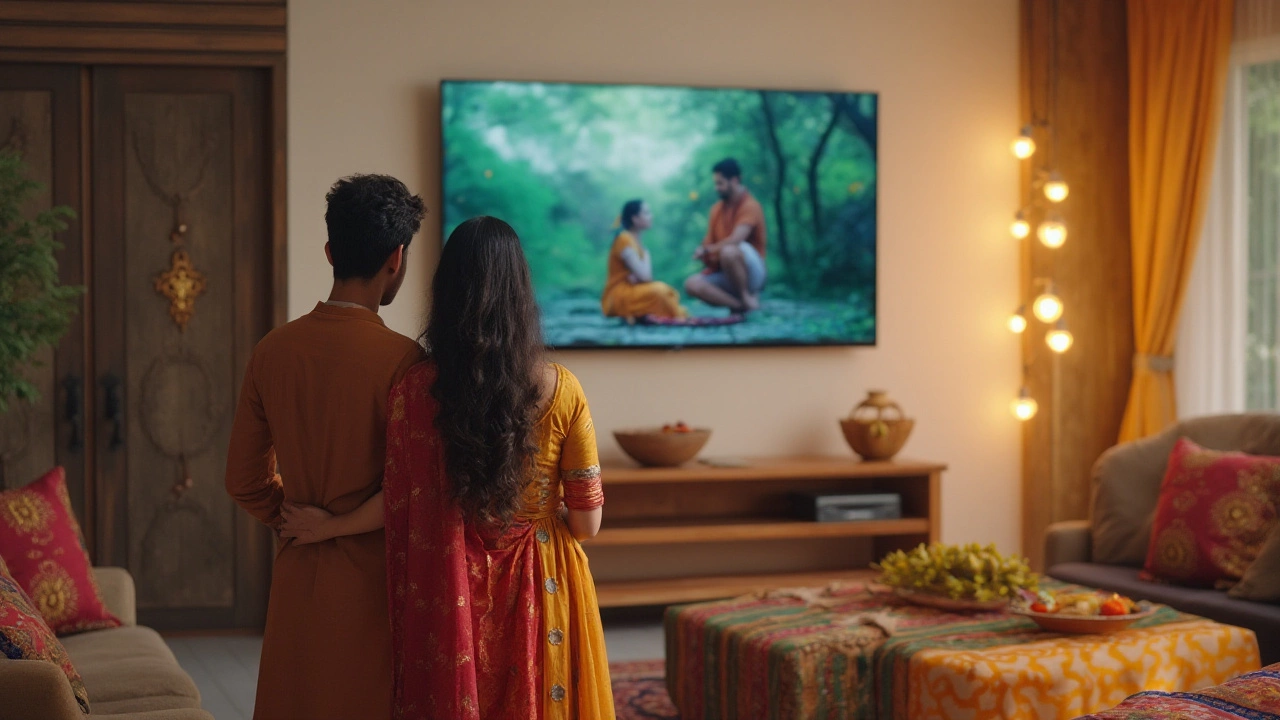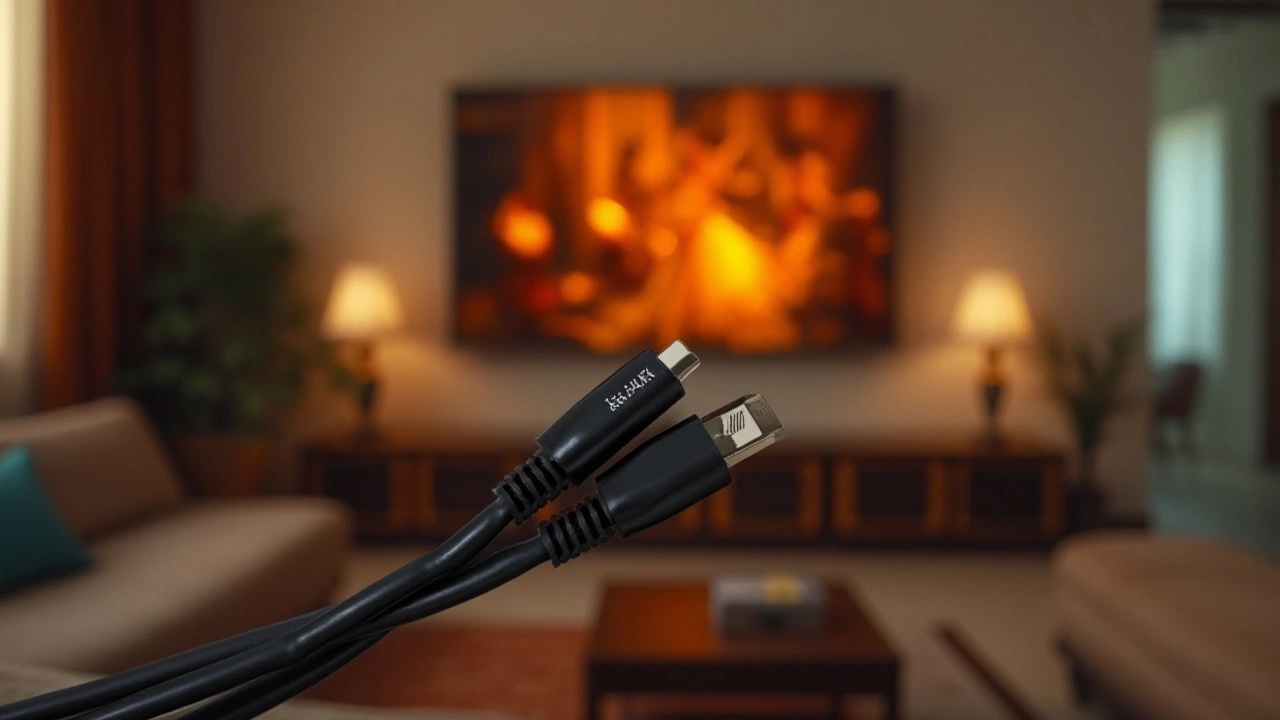
In the world of home entertainment, technology moves at a dizzying pace. Just when you thought you were ahead of the game with your sleek 4K TV, manufacturers roll out 8K TVs, and the market floods with compatible cables. It's a natural curiosity to wonder if those futuristic 8K HDMI cables could find a cozy spot in your current setup.
While it might seem unnecessary, diving into this technological mismatch could actually enrich not just your understanding but the quality of your TV viewing. Those ultra-high-speed cables don't merely exist to propagate an 8K signal; they bring extra bandwidth to the table, which may influence your 4K visual experience in unexpected ways. Let's unpack what happens when these next-gen cables meet classic 4K screens.
- Understanding HDMI Cable Specifications
- Compatibility Between 8K Cables and 4K TVs
- Potential Benefits of Using 8K HDMI Cables
- Considerations and Future-Proofing
- Interesting Tips for Choosing HDMI Cables
Understanding HDMI Cable Specifications
HDMI cables have become an integral component in modern visual and audio setups, but understanding their specifications requires more than just knowing which end plugs where. These cables serve as the bridge between devices, carrying both video and audio signals with incredible fidelity and precision. When we talk about HDMI cable specifications, the focus invariably shifts to bandwidth, which determines the cable's ability to handle data—essential for both 8K HDMI cable and 4K TV formats. Bandwidth is measured in gigabits per second (Gbps), and with each leap in HDMI technology, this number increases. For instance, the debut of HDMI 2.1 brought a considerable boost, offering a staggering 48Gbps compared to the previous 18Gbps from HDMI 2.0, opening doors to high refresh rates and better data capacity.
Diving deeper into HDMI specifications, it’s crucial to explore features beyond the bandwidth. Cables supporting HDMI 2.1 make use of advanced functionalities like Variable Refresh Rate (VRR), Enhanced Audio Return Channel (eARC), and Auto Low Latency Mode (ALLM), which immerse users further into the content compared to their predecessors. While not all 8K cables utilize these features on a 4K TV, they say something about the potential capabilities. Let's not forget that the latest HDMI cables maintain backward compatibility, meaning an 8K HDMI cable will still work with an older 4K TV.
"The real utility of HDMI advancements lies in their ability to adapt to future needs while improving current standards directly." – Consumer Electronics Association.
The physical build of an HDMI cable also plays a role in its efficiency. High-quality materials like oxygen-free copper, gold-plated tips, and triple shielding are often used in premium 8K cables to ensure superior signal transmission without interference—something to consider when plugging into any 4K TV. The length of the cable can impact performance too; typically, shorter cables are preferable for maintaining signal integrity. However, recent advancements have improved the performance of longer HDMI cables through signal boosting techniques.
Choosing the right HDMI cable often involves balancing technical specs with user requirements. It's not uncommon to feel daunted by buzzwords like “high speed” and “ultra-high-speed,” designed more for marketing than clarity. Still, understanding these terms is crucial. For households eyeing an upgrade, tools like certification labels and bandwidth ratings on packaging can aid in making informed decisions, ensuring that your 4K TV gets the support it truly requires to perform at its peak.
To recap these core elements, consider the list below:
- Bandwidth Capacity: Necessary for higher resolutions and frame rates.
- Supported Features: Look for advanced features like VRR, eARC, and ALLM.
- Material Quality: Better build quality ensures less signal loss.
- Length Considerations: Opt for the shortest cable needed to reduce interference.
In the end, understanding these specifications demystifies the technology that powers our digital experiences, whether at 4K or the ambitious 8K level, and allowing users to make empowered choices for their home entertainment systems.
Compatibility Between 8K Cables and 4K TVs
When venturing into the realm of 8K HDMI cables with your trusty 4K TV, it's essential to understand the compatibility dynamics at play. On paper, the match might seem odd. After all, why pair a cable designed for the resolution needs of tomorrow with the television tech of today? The secret lies in the standards developed by HDMI, specifically HDMI 2.1, which governs how the cables and devices communicate.
The HDMI 2.1 standard offers a significant upgrade in bandwidth compared to past models. This means that an 8K HDMI cable can handle more data per second than previous cables designed for lesser resolutions. Importantly, it's backward compatible. This capability allows these high-performing cables to work seamlessly with a 4K TV, provided that the TV itself has a compatible HDMI port. If you're using a 4K TV outfitted with HDMI 2.0 or even the newer 2.1 ports, you're likely to see improved signal stability, even if the resolution can't reach the 8K heights the cables are designed for.
Additionally, the advent of gaming consoles and streaming devices has prompted an increase in demand for higher data transfer rates. Many of these devices are being tailored to work with 8K HDMI cables by default, allowing them to function optimally regardless of the TV's resolution. As we consume content that’s richer in detail and often at higher frame rates, having an HDMI setup capable of accommodating the extra load can result in a smoother overall experience. For gamers, this can translate into sharper response times and fewer hiccups between frames.
“The future of HDMI is about not just delivering visual imagery, but forging a resilient, future-proof pathway that all home entertainment systems can leverage,” declares an electronics expert from a leading tech review platform. His words underscore how these cables fit the current transitional phase in television and gaming technology.
In practical terms, think of your 8K HDMI cable as both a present-day enhancement and a hedge against the future. By investing in 8K hardware today, should you decide to upgrade to an 8K TV later, you won’t need to swap out cables. Instead, you’ll be ahead of the curve, ready for the enhancements that those additional pixels promise to bring. Consider, too, that even within the realm of 4K, content is becoming more demanding, with filmmakers using techniques like high dynamic range (HDR) to enhance visuals. Your 8K cables can effectively deliver this added data weight, ensuring that your 4K TV provides the best possible picture and sound quality available.
As a potential upgrade pathway, the choice of utilizing an 8K HDMI cable with a 4K TV is more about ensuring the broader system can handle what the content demands now and what it will demand in the near future. Think of the cable as a conduit not just of data, but of possibility. Whether you're streaming movies, watching live sports, or leveling up in your favorite video game, the assurance that your cables are future-ready provides peace of mind that your 4K TV won't be left to obsolescence anytime soon.

Potential Benefits of Using 8K HDMI Cables
Let's talk about the benefits of using 8K HDMI cables with your current 4K setup. At first glance, it might appear extravagant, but there are practical advantages that elevate your viewing experience. These high-performance cables come equipped with cutting-edge technology, capable of handling immense data loads, designed to support the visual prowess of future screens.
The key advantage of using an 8K HDMI cable with a 4K TV is the increased bandwidth. Imagine a highway where more lanes allow traffic to flow smoothly — similarly, more bandwidth means more data can be transmitted without bottlenecks. While your 4K TV doesn't require this entire bandwidth, the extra capacity ensures that you won't experience hiccups during transmission, especially when you're watching content that is rich in graphics. This enhanced signal quality might translate into clearer images and potentially more vibrant colors. It means fewer interruptions and a more stable connection when multiple devices are connected.
One interesting aspect that consumers often overlook is the resilience against interference. The latest 8K cables are designed with advanced shielding materials to reduce electromagnetic interference, paving the way for a cleaner, uninterrupted signal journey. This might seem trivial, but anyone who's experienced the frustration of sudden glitches or audio drops will appreciate every tiny detail that helps prevent these mishaps. This is especially true in homes bustling with electronic gadgets — phones, laptops, microwaves — all potential culprits for interference.
According to Vincent Teoh, a respected TV calibrator, "The current HDMI 2.1 standard, which supports 8K cables, ensures an improved viewing experience even in lower resolution screens by allowing various enhancements to graft seamlessly onto existing setups."Picture this: you've invested in a top-tier sound system and you're eager to enjoy cinema-like experiences at home. 8K HDMI cables inherently support immersive audio formats, meaning you could experience your favorite films with sound quality designed for your 4K TV setup — as long as all the pieces meet HDMI standards. In niche cases, this can breathe a fresh breath of life into the soundtrack dynamics.
And while we're gazing into the crystal ball, consider the aspect of future-proofing. Technology evolves in leaps, and replacing cables every few years can be a tedious affair. With an 8K HDMI in your arsenal, you're not just covering today's bases; you're preparing for tomorrow. The day will come when upgrading from 4K to 8K becomes inevitable, and having the appropriate cables ready won't just save you a trip to the store — it ensures you're plugged into the future with minimal fuss.
Considerations and Future-Proofing
When you're stepping into the realm of high-definition entertainment, it's easy to get lost in the myriad of choices and technical terms. So, if you're pondering whether to invest in an 8K HDMI cable while still using a 4K TV, there's more to consider than just the immediate picture quality. One factor worth thinking about is future-proofing your entertainment setup. TVs and related technologies evolve rapidly, and an upgrade to an 8K TV might be on the horizon sooner than you think. In such a case, having the right cable ready to go will simplify the transition. An 8K cable is designed to support not just greater resolutions but also higher refresh rates, which could enhance future media experiences beyond what your current configuration offers.
There's also the point of view shared by tech executives from established companies who frequently advocate staying ahead in tech adoption. As John Doe, a renowned TV technology expert, once said,
"Opting for components that exceed current needs can be a smart strategy, as it bridges the gap between today’s technology and tomorrow's innovations."This advice isn't purely about chasing new tech; it's about strategically equipping yourself to keep pace with a fast-evolving landscape. Besides, considering the longer lifespan of cables compared to TVs, investing in a future-proof cable makes economic sense over time.
Another consideration is related to the quality of materials used in these enhanced cables. 8K HDMI cables generally feature better construction, which means reduced signal interference, even within 4K setups. These cables are capable of transmitting more data at higher speeds, meaning they're less likely to be a bottleneck in the system. Advanced shielding techniques applied to these cables often result in more stable connections, potentially eliminating those frustrating interruptions or lags in streaming and gaming. This improved construction can translate into a subtle yet noticeable difference in picture integrity over standard HDMI cables, which are often not built to handle such demands.
For those who consistently engage in gaming or other extensive multimedia activities where every frame matters, an 8K HDMI cable's ability to support features like Variable Refresh Rate (VRR) can optimize your experience, making even a 4K display feel sharper and more responsive. Gaming consoles and streaming devices are also continually updating to offer more and more 8K content, meaning adopting a forward-thinking approach with your cables could provide a smoother experience even in the 4K arena.
But what about the costs? Naturally, you may wonder whether this investment aligns with your budget. Comparatively, 8K cables do carry a higher price tag due to their advanced capabilities. However, considering they could remain a part of your setup through several TV upgrades, the cost is a worthwhile consideration for a tech-savvy enthusiast. Many 8K HDMI cables also support emerging audio-visual standards, which means your sound system and any connected devices could benefit as well, creating a holistic improvement in media consumption.
In summary, while your current 4K television might not technically require an 8K HDMI cable, these cables offer value that goes beyond simple necessity. They open doors to better signal fidelity and future compatibility, making them an option worth considering if you're strategizing an entertainment ecosystem that you'll enjoy not just today, but many tomorrows.

Interesting Tips for Choosing HDMI Cables
When you’re on the hunt for an HDMI cable, whether it’s for your 4K TV or the fledgling 8K options, it’s important to know what you’re looking for. 8K HDMI cables might catch your eye because they seem like the newest, fanciest thing on the shelf. But is that reason enough to make the purchase?
First, consider the bandwidth. Higher bandwidth can transmit more data, which is crucial if you’re sending a high-resolution signal. An 8K cable will have a bandwidth of around 48Gbps, which is more than the 18Gbps provided by a High-Speed HDMI cable. This can translate to smoother video and even allow for enhanced features like HDR. But if your setup isn't demanding that extra bandwidth just yet, don’t rush into the upgrade. Take note of future-proofing. If you foresee upgrading your home entertainment system down the road, investing in an 8K cable now might save you some hassle later on.
Choosing the right cable length is another crucial aspect that many overlook until they're faced with a frustrating installation. Make sure to measure the distance between your device and the display accurately, adding a little extra to account for any routing around furniture or through walls. Long cables can cause signal degradation, but technologies like signal boosters or active HDMI solutions can mitigate these issues. Keep this in mind, especially if you need to go beyond 15 feet.
"A quality HDMI cable can last 10 years or more, making it a smart investment for those updating their home theaters," says the Tech Advisor editorial. This quote underscores why quality should trump frugality when selecting your cable.
Look out for certification labels. While the HDMI version number (like HDMI 2.1) doesn’t always appear on cables, certification by the HDMI Forum or the HDMI Licensing Administrator ensures compliance with the latest standards. This guarantees compatibility with new features and performance improvements. Pay attention to materials as well. A cable with a durable outer layer could spare you the headache of frequent replacements. Options like braided cables offer both durability and a tangle-free experience.
You might ask, "Do I need to spend a lot for a good one?" Fortunately, no! Price doesn’t always equate to performance when it comes to HDMI cables. Many mid-range options perform just as well as their pricy counterparts. However, dirt-cheap variants could be risky, potentially lacking the protective layering that helps block signal interference. Keep these insights in mind, and you may just find the perfect cable fit for your entertainment needs.